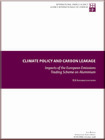14 October 2008: The International Energy Agency (IEA) has released a new Information Paper exploring the effects of the EU emissions trading scheme (EU ETS) on the aluminum sector.
The Paper analyzes whether the European primary aluminum sector, whose direct emissions are not capped by the EU ETS, is negatively impacted by the EU ETS […]
 14 October 2008: The International Energy Agency (IEA) has released a new Information Paper exploring the effects of the EU emissions trading scheme (EU ETS) on the aluminum sector.
14 October 2008: The International Energy Agency (IEA) has released a new Information Paper exploring the effects of the EU emissions trading scheme (EU ETS) on the aluminum sector.
The Paper analyzes whether the European primary aluminum sector, whose direct emissions are not capped by the EU ETS, is negatively impacted by the EU ETS as the carbon constraints result in higher electricity prices. The report concludes that primary aluminum has not suffered from carbon leakage to date, but that more ambitious climate
policy goals may alter this picture. The report defines carbon leakage as the increase in emissions outside a region as a direct result of the policy to cap emissions in that region. As the price of aluminum is set globally, European producers are unable to raise prices to reflect increased costs due to climate policy, which can result in carbon leakage.
The report analyzes the loss of market share for carbon-constrained industrial products and relocation of energy-intensive industries to countries with a more favorable climate policy. The report considers two indicators of competitiveness for a sector in a given region: the estimated profit margins of primary aluminum smelters and trade flows. It further notes that production costs of a ton of primary aluminum in Europe are higher than in many other regions, but that this was already the case before the entry into force of carbon constraints. According to the report, the main reasons for this competitive disadvantage are differences in labor and power costs. [The Information Paper]